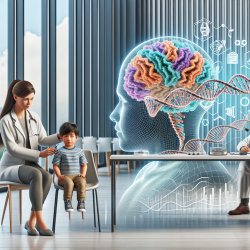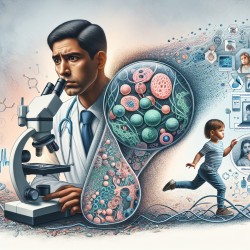Introduction
In the ever-evolving field of speech-language pathology, the integration of genetic research into clinical practice is becoming increasingly crucial. A recent study titled Genome sequencing identifies three molecular diagnoses including a mosaic variant in the COL2A1 gene in an individual with Pol III–related leukodystrophy and Feingold syndrome provides groundbreaking insights that could significantly impact the way speech-language pathologists approach diagnosis and treatment, particularly in pediatric cases.
The Study and Its Findings
This research, conducted by Muirhead et al. (2021), highlights the power of genome sequencing (GS) in diagnosing complex genetic disorders. The study presents a case where trio genome sequencing identified three distinct molecular diagnoses in a child with suspected leukodystrophy: a compound heterozygous missense variant associated with Pol III-related leukodystrophy, a 4-Mb de novo copy-number loss including the MYCN gene linked to Feingold syndrome, and a mosaic single-nucleotide variant associated with COL2A1-related disorders.
Implications for Speech-Language Pathologists
Understanding the genetic underpinnings of speech and language disorders can lead to more targeted and effective interventions. Here are several ways speech-language pathologists can utilize these findings:
- Enhanced Diagnostic Accuracy: By incorporating genetic information, practitioners can better understand the etiology of speech and language disorders, particularly in complex cases where multiple diagnoses may overlap.
- Customized Intervention Plans: Knowledge of specific genetic variants can inform the development of personalized therapy plans that address the unique needs of each child.
- Early Intervention: Identifying genetic markers early can facilitate timely interventions, potentially mitigating the severity of speech and language impairments.
Encouraging Further Research
While the study underscores the potential of GS in diagnosing complex disorders, it also highlights the need for ongoing research. Speech-language pathologists are encouraged to stay informed about advancements in genetic research and consider participating in interdisciplinary studies. Collaborative efforts between geneticists and speech-language pathologists can lead to a deeper understanding of how genetic variations influence speech and language development.
Conclusion
As the field of genetics continues to advance, its integration into speech-language pathology will be pivotal in enhancing diagnostic and therapeutic outcomes. By leveraging the insights from studies like the one conducted by Muirhead et al., practitioners can provide more effective and personalized care to children with speech and language disorders.
To read the original research paper, please follow this link: Genome sequencing identifies three molecular diagnoses including a mosaic variant in the COL2A1 gene in an individual with Pol III–related leukodystrophy and Feingold syndrome.










